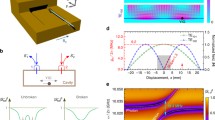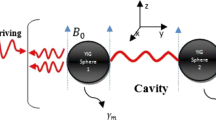Abstract
The magnon-induced transparency and magnon-induced slow light in a hybrid cavity–magnon system are analysed by using a set of experimentally realizable parameter. The cavity is driven by a strong microwave control field and a weaker probe field. The absorption and dispersion properties of the probe field are illustrated in detail. The transmission profile shows line shape structure. This line shape can be tuned via photon–magnon coupling rate, decay rate and applied magnetic field. The transmission profile also shows double-window magnon-induced transparency which supplies an additional degree of freedom of the present system. The phase of the transmitted field shows both anomalous and normal dispersion. The phase variation confirms that the group velocity shows both positive and negative values. The model system also shows slow light effect which can be controlled by applied magnetic field. This study may find applications in magnon-based quantum information processing and also the magnetic field-controlled low-power amplifier.






Similar content being viewed by others
Data Availability Statement
There are no associated data for this manuscript.
References
I. Zutic, J. Fabian, S. Das Sarma, Spintronics: fundamentals and applications. Rev. Mod. Phys. 76, 323–410 (2004)
A.V. Chumak, V.I. Vasyuchka, A.A. Serga, B. Hillebrands, Magnon Spintronics. Nat. Phys. 11, 453–461 (2015)
A. Hirohata et al., Review on spintronics: priciples and device applications. J. Magn. Magn. Mater. 509, 166711 (2020)
A. Kamra, W. Belzig, A. Brataas, Magnon-squeezing as a niche of quantum magnonics. App. Phys. Lett. 117, 090501 (2020)
P. Pirro, V.I. Vasyuchchka, A.A. Serga, B. Hillebrands, Advances in coherent magnonics. Nat. Rev. Mater. 6(12), 1114–1135 (2021)
W. Zhang, T. Wang, X. Han, S. Zhang, H.-F. Wang, Quantum entanglement and one way steering in a cavity magnomechanical system via a squeezed vacuum field. Opt. Exp. 30, 10969 (2022)
O.O. Soykal, M.E. Flatte, Strong field interactions between a nanomagnet and a photonic cavity. Phys. Rev. Lett. 104, 077202 (2010)
H. Huebl et al., High cooperativity in coupled microwave resonator ferrimagnetic insulator hybrids. Phys. Rev. Lett. 111, 127003 (2013)
X. Zhang, C.L. Zou, L. Jiang, H.X. Tang, Strongly coupled magnons and cavity microwave photons. Phys. Rev. Lett. 113, 156401 (2014)
Y. Tabuchi et al., Hybridizing ferromagnetic magnons and microwave photons in the quantum limit. Phys. Rev. Lett. 113, 083603 (2014)
Y. Tabuchi et al., Quantum information. Coherent coupling between ferromagnetic magnon and a superconducting qubit. Science 349, 405 (2015)
Z.-X. Liu, H. Xiong, M.-Y. Wu, Y.-Q. Li, Absorption of magnons in dispersively coupled hybrid quantum systems. Phys. Rev. A 103, 063702 (2021)
Z.-X. Liu, Y.-Q. Li, Optomagnonic frequency combs. Photon. Res. 2786, 10 (2022)
Z.-X. Liu, J. Peng, H. Xiong, Generation of magnonic frequency combs via a two-tone microwave drive. Phys. Rev. A 107, 053708 (2023)
D.D. Stancil, A. Prabhakar, Spin waves theory and applications (Springer, NewYork, 2008)
Z.-X. Liu, B. Wang, H. Xiong, Y. Wu, Magnon-induced higher-order side band generation. Opt. Lett. 43, 3698 (2018)
Z.-X. Liu, C. You, B. Wang, H. Xiong, Y. Wu, Phase mediated magnon chaos-order transition in cavity optomechanics. Opt. Lett. 44, 3 (2019)
G.-Q. Zhang, Z. Chen, W. Xiong, C.-H. Lam, J.Q. You, Parity-symmetry-breaking quantum phase transition via parametric drive in a cavity magnonic system. Phys. Rev. B 104, 064423 (2021)
R.E. Slusher, H.M. Gibbs, Self-induced transparency in atomic Rubidium. Phys. Rev. A 5, 1634 (1972)
B.P. Hou, S.J. Wang, W.L. Yu, W.L. Sun, Double electromagnetically induced two-photon transparency in a five-level atomic system. Phys. Lett. A 352, 462 (2006)
S.J. Li et al., Two electromagnetically induced transparency windows and an enhanced electromagnetically induced transparency signal in a four-level tripod atomic system. J. Phys. B At. Mol. Opt. Phys. 40, 3211 (2007)
S. Weiss et al., Optomechanically induced transparency. Science 330, 1520 (2010)
K. Mukherjee, P.C. Jana, Optically induced transparency in coupled micro-cavities: tunable Fano resonance. Eur. Phys. J. D 73, 264 (2019)
X.-F. Zhang, C.-L. Zou, L. Jiang, H.X. Tang, Cavity magnomechanics. Sci. Adv. 2, e1501286 (2016)
H.M.M. Alotaibi, B.C. Sanders, Double-double electromagnetically induced transparency with amplification. Phys. Rev. A 89, 021802(R) (2014)
E.C. Diniz et al., Multiple transparency windows and Fano interferences induced by dipole-dipole couplings. Phys. Rev. A 97, 043848 (2018)
X.Q. Luo et al., Nonlinear optical behavior of a four-level quantum well with coupled relaxation of optical and longitudinal phonons. Phys. Rev. A 84, 033803 (2011)
J.T. Hill et al., Coherent optical wavelength conversion via cavity optomechanics. Nat. Commun. 3, 1196 (2012)
J.Q. Zhang et al., Precision measurement of electrical charge with optomechanically induced transparency. Phys. Rev. A 86, 053806 (2012)
A. Kasapi, M. Jain, G.Y. Yin, S.E. Harris, Electromagnetically induced transparency: propagation dynamics. Phys. Rev. Lett. 74, 2447 (1995)
K. Mukherjee, P.C. Jana, Probe response of a two-mode cavity with χ2 nonlinearity, non-reciprocity and slow and fast light. App. Phys. B 127, 168 (2021)
T. Baba, Slow light in photonic crystals. Nat. Photonics 2, 465–473 (2008)
T.F. Krauss, Why do we need slow light? Nat. Photonics 2, 448–450 (2008)
L. Thevenaz, Slow and fast light in optical fibres. Nat. Photonics 2, 474–481 (2008)
H.J. Kimble, The quantum internet. Nature 453, 1023 (2008)
R.S. Tucker, P.C. Ku, C.J. Chang-Hasnian, Slow-light optical buffers: capabilities and fundamental limitations. J. Light Wave Tech. 23, 4046–4066 (2005)
Y.-M. Huang, Z.-Q. Hua, Y.-Q. Yang, Y.-M. Zhao, Magnon-photon induced transparency in a cavity-quantum-electrodynamics system coupling yttrium-iron-garnet sphere. Result Phys. 15, 102516 (2019)
B. Wang, Z.-X. Liu, C. Kong, H. Xiong, Y. Wu, Magnon induced transparency and amplification in PT-symmetric cavity-magnon system. Optic Expr. 26, 20248 (2018)
Y.-L. Ren et al., Non-reciprocal optical transmission in cavity optomagnonics. Opt. Exp. 29, 41399 (2021)
X. Zhang, C.-L. Zou, N. Zhu, F. Marquardt, L. Jiang, H.X. Tang, Magnon dark modes and gradient memory. Nat. Commun. 6, 8914 (2015)
K. Mukherjee, P.C. Jana, Magnon bistability in a hybrid cavity-magnon system. J. Korea. Phys. Soc. 82, 356 (2023)
C. Kittle, On the theory of ferromagnetic resonance absorption. Phys. Rev. 73, 155 (1948)
T. Holstein, H. Primakoff, Field dependence of the intrinsic domain magnetisation of a ferromagnet. Phys. Rev. 58, 1098 (1940)
S. Blundell, Magnetism in condensed matter (Oxford University Press, Oxford, 2001)
Z. Zhang, M.O. Scully, G.S. Agarwal, Quantum entanglement between two magnon modes via Kerr nonlinearity driven far from equilibrium. Phys. Rev. Res. 1, 023021 (2019)
J.A. Haigh et al., Selection rules for cavity enhanced Brillouin light scattering from magnetostatic modes. Phys. Rev. B 97, 214423 (2018)
C. Kong et al., Magnetically controllable slow light based on magnetostrictive forces. Opt. Exp. 27, 5544 (2019)
Y.-P. Wang et al., Bistability of cavity magnon polaritons. Phys. Rev. Lett. 120, 057202 (2018)
Y. Wei et al., Quantitative analysis of magnon induced second-order sideband generation. IEEE Access 4, 2929912 (2016)
M. Wang et al., Magnon chaos in PT-aymmetric cavity Magnomechanics. IEEE Photonics J. 11, 5300108 (2019)
C. Zhao, Z. Yang, R. Peng, J. Yang, C. Li, L. Zhou, Dissipative-coupling-induced-transparency and higher-order sidebands with Kerr nonlinearity in a cavity-magnonics system. Phys. Rev. App. 18, 044074 (2022)
M.-S. Ding, L. Zheng, C. Li, Phonon laser in a cavity magnomechanical system. Sci. Rep. 9, 15723 (2019)
S. M. -L. Ricon et al. Measuring the magnon-photon coupling in shaped ferromagnets: tuning of the resonance frequency, arXiv: 2207.03829v1, Cond-mat.mes-hall (2022)
V. Cherepanov, I. Kolokolov, V. L’vov, The Saga of YIG: spectra, thermodynamics, interaction and relaxation of magnons in a complex magnet. Phys. Rep. 229, 81 (1993)
M.O. Scully, M.S. Zubairy, Playing tricks with slow light. Science 301, 181 (2003)
L.V. Hau, S.E. Harris, Z. Dutton, C.H. Behroozi, Light speed reduction to 17 meters per second in an ultra cold atomic gas. Nature 397, 594 (1999)
A.H. Safavi- Naeini et al., Electromagnetically induced transparency and slow light with optomechanics. Nature (London) 472, 69 (2011)
Z.-X. Liu, H. Xiong, Y. Wu, Room-temperature slow light in a coupled cavity magnon-photon system. IEEE Access 7, 57047–57053 (2019)
Author information
Authors and Affiliations
Corresponding author
Rights and permissions
Springer Nature or its licensor (e.g. a society or other partner) holds exclusive rights to this article under a publishing agreement with the author(s) or other rightsholder(s); author self-archiving of the accepted manuscript version of this article is solely governed by the terms of such publishing agreement and applicable law.
About this article
Cite this article
Mukherjee, K., Jana, P.C. Magnon-induced transparency and amplification in a hybrid cavity–magnon system. Eur. Phys. J. Plus 138, 1127 (2023). https://doi.org/10.1140/epjp/s13360-023-04783-8
Received:
Accepted:
Published:
DOI: https://doi.org/10.1140/epjp/s13360-023-04783-8




